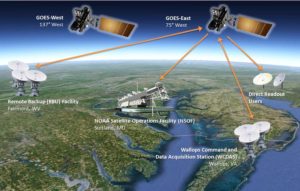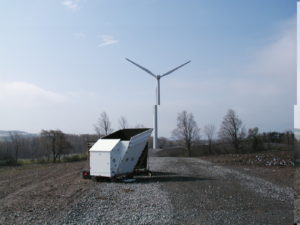
GOES-R, what’s that?
Did you ever hear about GOES-R? If you didn’t, continue and broaden your mind! GOES-R is the next generation of geostationary weather satellites in US – the connotation: Geostationary Operational Environmental Satellite-R Series – and is scheduled to launch in early 2016. As we all know the characteristic to remain stably over a point of the earth’s surface makes geostationary satellites highly useful for observing environmental conditions such a weather, atmosphere and fires on the one hand, the other broad span of application is for telecommunications. GOES-R is the successor of GOES-14 and is a cooperation between NOAA and NASA. While NOAA is going to manage the program, an integrated NOAA-NASA office organisation with personnel coming from both is co-located at NASA’s Goddard Space Flight Center in Greenbelt, Maryland. The GOES-R series is going to continue the 2-satellite system, with operating satellites at 75W and 137W. The main purpose is to continue the observation of weather and atmospheric occurrences with enhanced instruments that will permit improved hurricane track and intensity forecast, real-time mapping of lightning and thus an increased performance in thunderstorm and tornado warning, improved geomagnetic storm forecasting which is important for GNSS and finally improved monitoring of solar features. See a detailed list of the most important sensors in the following section.
Technical improvements
The GOES-R program will mark the first major technological advances in geostationary observations since 1994. Compared to the current GOES program a couple of new instruments and data processing methods will provide a better quality of observation:
Advanced Baseline Imager (ABI):
- Four times greater ground resolution
- Five times faster coverage
- Three times more spectral bands (16 bands including 2 visible, 4 near infrared and 10 infrared channels, the number of bands will enable to observe nI and I without degrading influence of cloud cover)
- Higher coverage simultaneously
Geostationary Lightning Mapper (GLM):
- Real time mapping of lightning activity over land and water
The monitoring of solar features is of great importance for aviation flights, spaceflight and astronauts in terms of security. The new sensors on GEOS-R will be:
Solar Ultra Violet Imager (SUVI):
SUVI will observe the sun in the extreme ultra violet wavelength and will provide full-disk solar images with approximately 5 arcsec spatial resolution at 10 second imaging cadence. SUVI will observe and characterize complex active regions of the sun, solar flares, and the eruptions of solar filaments which may give rise to coronal mass ejections. The main goals of SUVI are:
- Locate coronal holes for geometric storm forecasts
- Detect and locate flares for forecasts of solar energetic particle events related to flares
- Monitor changes in the corona that indicate Coronal Mass Ejections (CMEs)
- Detect active regions beyond the east limb for activity forecasts
- Analyze active region complexity for flare forecasts
EUV and X-Ray Irradiance Sensors (EXIS):
EXIS detects solar X-ray and solar extreme ultraviolet irradiance in the 5-127 nm range. It will monitor:
- Solar flares that can disrupt communications and degrade navigational accuracy affecting satellites, astronauts, high latitude airline passengers, and power grid performance.
- Solar variations that directly affect satellite drag/tracking and ionospheric changes, which impact communications and navigation operations.
Space Environment In-Situ Suite (SEISS):
SEISS will monitor the proton, electron, and heavy ion fluxes at geosynchronous orbit, which is e.g. critical for estimating the radiation that is hazard to astronauts and satellites. For earth relevant purposes SEISS will warn of high flux events, mitigating any damage to radio communication.
Magnetometer (MAG):
The GOES-R Magnetometer will provide measurements of the space environment magnetic field that controls charged particle dynamics in the outer region of the magnetosphere. These particles can be dangerous to spacecraft and human spaceflight.
Improved instruments also require an enhanced data transmission. The GOES-R Unique Payload Service (UPS) will permit high rate information transmission that is necessary to deliver actual information to immediately to where it is needed.
The operation architecture of the new GOES-R series. Scheme GOES-R mission.
GOES-R mission: Video
The importance of historic data and some thoughts about meteorology
In Europe meteorological data have been recorded since the 18th century, at this time mainly by royal institutions. In Austria, for instance, the ZAMG (Central Institution for Meteorology and Geodynamics/ Zentralanstalt für Meteorologie und Geodynamik) was founded in 1851 for observing climate by recording meteorological parameters. Already in 1873 the first international meteorological congress took place in Vienna with delegates coming from 16 different countries (Belgium, China, Denmark, Germany, UK, Ireland, Italy, The Netherlands, Norway, Austrian-Hungarian Monarchy, Portugal, Russia, Sweden, Switzerland, Spain and Turkey). At this date the International Meteorological Organisation (IMO), ancestor of the WMO, was founded with the purpose of exchanging meteorological information. I’d say, that meteorology has a long tradition and since that time, different weather features were permanently recorded. This proofes to be highly beneficial for topics as climate change when today we are able to compare those data with the most recent ones and to create climate time series. The new epoch of earth observation allows monitoring far more parameters than only meteorological ones. Like the meteorological time series from the last two centuries those new data will constitute a precious source of information in future. Let’s keep that in mind!
Did you like this article? Read more and subscribe to our monthly newsletter!











